 |
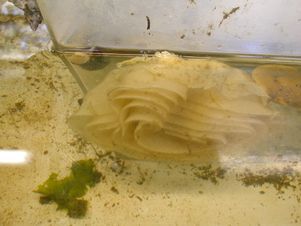 |
|
|
|
Three major methods of reproduction are evident among
animals found at Argyle Creek: egg laying, brooding, and free-spawning.
Because free-spawning is the dominant mode, many of the animals in Argyle
Creek, which are benthic as adults, go through a free-swimming planktonic
stage as larvae.
EGG LAYING
The deposition of fertilized eggs in a gelatinous mass
is used by only a few of the species in Argyle, including nudibranchs and
gastropods. The eggs take different forms, from soft ribbons of the nudibranch
Archidoris montereyensis to the hardened egg capsules of the whelk
Nucella lamellosa. These structures produce a veliger
larvae that, in the nudibranch, hatches from the embryo mass and spends
time in the plankton as a feeding larval form.
whelk, metamorphoses into the juvenile form within the
egg capsule, while in the nudibranch the veliger hatches from the embryo
mass and spends time in the plankton as a feeding larval form.
 |
 |
|
|
|
Lacuna is another snail that has internal fertilization,
but it deposits a different type of egg mass. Lacuna lay many
eggs in a gelatinous doughnut-shaped structure on algae. Veliger
larvae hatch and feed in the plankton for 4-6 weeks. One possible cue for
these larvae to metamorphose into benthic juveniles is the presence of
the algae that juveniles consume. Lacuna produces egg masses year-round.
Development time is highly
dependent on temperature--masses kept at a warmer temperature develop
much faster than those kept at a lower temperature. This suggests that
development of Lacuna in Argyle Creek--where temperatures
can vary by 10 degrees C on warm days--may be faster than where temperature
variation is less extreme.
 |
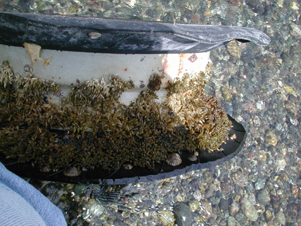 |
| Nucella egg capsule in close-up view (left) and many capsules deposited on an abandoned tire at Argyle (right). | |
BROODING
The few animals that brood embryos at Argyle include the brachyuran crabs and the tiny brittlestar Amphipholis squamata. Brachyuran crabs hold their brooded embryos between the underside of the thorax and the abdomen, which is curled up beneath the thorax. Embryos hatch at a prezoea larval stage and then spend time feeding in the plankton until they settle out as benthic juveniles.
The brittlestar A. squamata broods its young until
it is a fully functional juvenile brittlestar that resembles the adult.
Eggs are fertilized and incubated in the genital bursae,
small pockets on each side of each arm. Ova are released into the
bursa singly and develop into small juveniles. Several embryos may develop
simultaneously in a single bursa. The bursal is thought to provide some
nourishment to the developing larvae. It is a remarkable experience for
the biologist to find even tinier offspring within the bursal slits of
tiny adults. Juveniles emerge from the bursa through the bursal slits
or through the aboral body wall of the parent. Sometimes the aboral portion
of the parental disk is shed prior to emergence of the juveniles. This
brooding technique results in the young finding the correct habitat when
released.
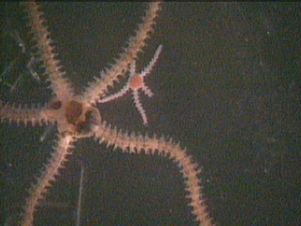 |
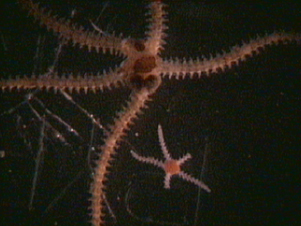 |
|
|
|
FREE-SPAWNING
Spawning is the most common reproductive mode for animals at Argyle Creek. These organisms release their gametes into the water column where fertilization occurs externally. The embryos live in the plankton for some time until they metamorphose and settle to become mature animals. Common free spawners include bivalves and some polychaetes.
The oyster Crassostrea gigas may shed gametes repeatedly over a season. This species was originally introduced from Japan and has now found a good niche in the waters of the Pacific coast. Crassostrea gigas spawns from late June through September, though initiation of gametogenesis depends on ambient temperature. Gametes are released into the mantle cavity and are ejected through rhythmic contractions of the adductor muscles. A single female can release up to 56 million eggs per spawning and over 90 million eggs in 1 month. Adults may also spawn repeatedly over one season. The zygote will develop into a straight-hinged veliger larva within 48 hours after fertilization. Larvae tend to vertically migrate in the plankton, spending time in the upper 2 meters at night and at 6-8 meters during sunny days. Veligers feed on algal cells under 10 micrometers in diameter. The veliger larvae are in the plankton for a period of 10 to 30 days, depending on the temperature of the water. Metamorphically competent pediveliger larvae settle and metamorphose within 36 hours after addition of crushed clean oyster shell. The shell has some form of indicator for the larvae to know that they are in a good place to settle.
Oysters are known to settle gregariously. Possible
reasons for the abundance of oysters in Argyle Creek is the warm water
in the lagoon and the proper chemical cues provided by other oysters for
metamorphosis. The lagoon may help to retain veliger larvae, promoting
settlement within the creek.
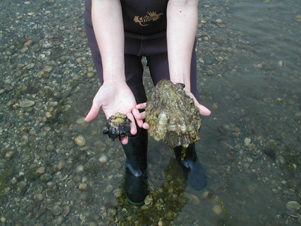 |
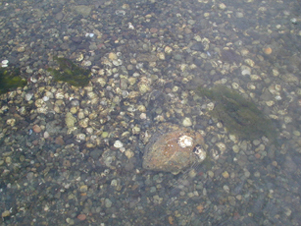 |
|
|
|